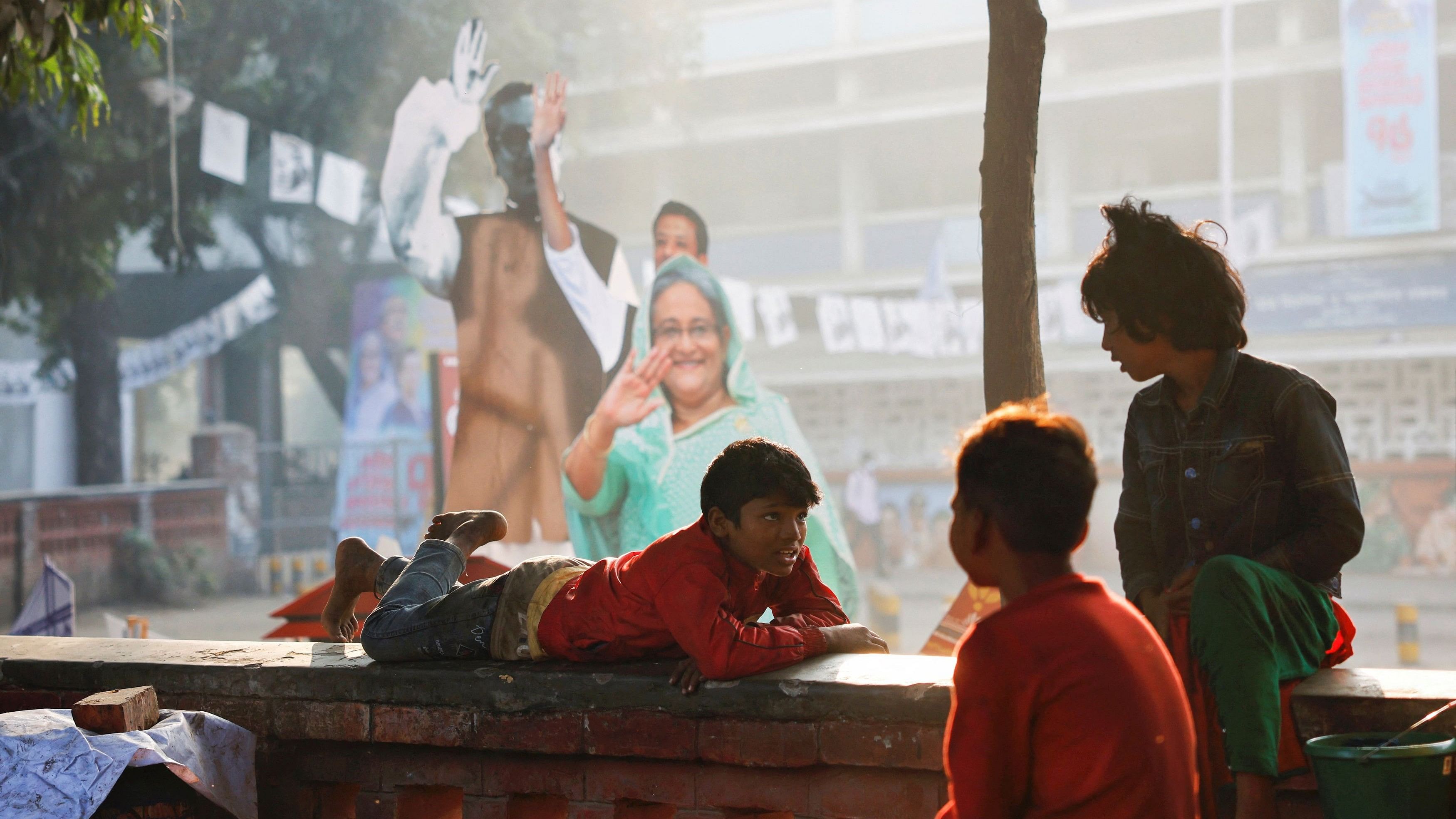
Children chat at the University of Dhaka with an installation of the picture of Sheikh Hasina.
Credit: Reuters Photo
By Mihir Sharma
The results of Bangladesh’s election last weekend were pre-ordained: Prime Minister Sheikh Hasina’s party, the Awami League, won for the fourth consecutive time. Hasina, already the world’s longest-serving female head of government, will now embark on another five-year term.
The League’s pitch to voters was simple: The party had helped the country post impressive growth numbers and should be allowed to keep doing so. Its victory was overwhelming. Sheikh Hasina should not, however, take that as a mandate to continue with business as usual.
Bangladesh is a growth Star
Credit: Bloomberg
For one thing, turnout in the elections was only 40 per cent, suggesting a large proportion of the electorate responded to calls by the country’s main opposition party, the Bangladesh Nationalist Party, to boycott the vote. The BNP wanted elections to be conducted under an independent caretaker administration; instead, the Awami League stayed in office. The US State Department said this week that it agrees with the opposition that “these elections were not free or fair.” The UK also expressed concern over the arrest of opposition members ahead of the vote.
Several of Bangladesh’s regional partners — especially India and Japan — believe continuity in Dhaka is a good thing. India worries that the BNP is too soft on Islamists, and Japan believes that Bangladesh under Sheikh Hasina will be a firm partner in Tokyo’s efforts to forge a new, Asia-centric security framework to counter China.
But the US is Bangladesh’s largest trading partner, and it would be bad news for the country if its relationship with West broke down over human-rights concerns. Trade sanctions could devastate its export-dependent economy.
Even without them, Bangladesh ought to be urgently rethinking its growth model. To date, the country has carefully followed the advice given by every mainstream development economist: Small developing countries should concentrate on increasing exports to the rich world. Decades ago, Dhaka’s policy makers decided to focus on the ready-made garments trade. They succeeded: The country of 170 million people is now the world’s second-largest clothing exporter, behind only China.
It hasn’t always been easy. In 2013, over 1,110 people died when an eight-story building called Rana Plaza collapsed. It was home to multiple small garment factories making clothes for brands such as Primark and Zara. There was outrage, at home and abroad, that workers were toiling away in unsafe conditions.
The government had to respond swiftly. Together with major brands and trade unions, it signed an “accord on fire and building safety” — called the Bangladesh Accord — committing to more regular inspections and giving workers a larger voice in safety complaints.
Today, Bangladesh faces a problem generated by its own success. The garments sector has become so efficient and profitable that it soaks up all of Dhaka’s policy attention, as well as all of the country’s spare capital and entrepreneurial energy. As a result, Bangladesh’s exports are perilously imbalanced.
A Dangeroud dependence
Credit: Bloomberg
According to the country’s central bank, the garments sector was responsible for 85.9 per cent of the country’s export earnings between October and December of 2022. And nine countries — the US, UK, Canada, and five large European economies — accounted for more than 70 per cent of those exports.
That dependency renders the country vulnerable to more than sanctions. Bangladesh has for years been the top beneficiary of the various exceptions to tariffs and intellectual property requirements granted to the world’s “least developed” countries: Nearly three-quarters of its exports take advantage of one or another special exemption. The country is due to graduate from LDC status in 2026 and could lose those privileges.
Before then, the new government must figure out how to lock in tariff-free access to the country’s main export markets, ideally through signing various free-trade agreements. Trade pacts with markets in its own region — particularly the economies of Southeast Asia — also ought to be a priority. Bangladesh is one of the least regionally integrated economies in the world. Although three-quarters of its merchandise imports come from Asia, only 16 per cent of its exports are sold back to the region.
Even more importantly, Bangladesh will need to work harder to develop new export industries, from pharmaceuticals to software services. While it has the human capital and technical prowess to sustain these sectors, they haven’t yet taken off.
Partly that’s because the Awami League’s long tenure has created strong domestic interest groups and incumbent firms with no interest in altering the status quo. A more modern policy mix — one that broadens access to capital and encourages innovation — isn’t what these entrenched interests want to see. If Sheikh Hasina really wants her country to remain a success, she will need to seek out new supporters.